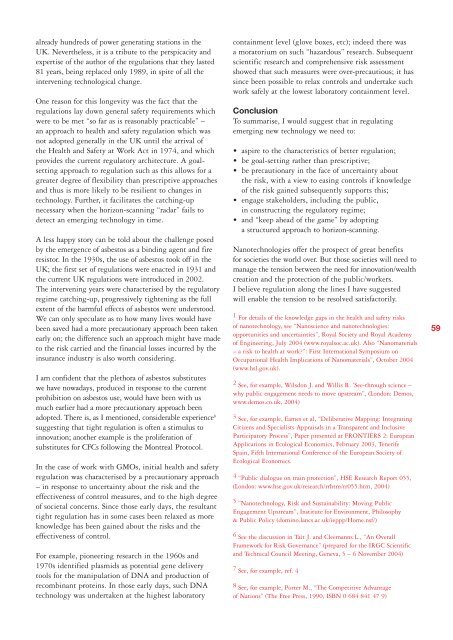Small size - large impact - Nanowerk
Small size - large impact - Nanowerk
Small size - large impact - Nanowerk
You also want an ePaper? Increase the reach of your titles
YUMPU automatically turns print PDFs into web optimized ePapers that Google loves.
already hundreds of power generating stations in the<br />
UK. Nevertheless, it is a tribute to the perspicacity and<br />
expertise of the author of the regulations that they lasted<br />
81 years, being replaced only 1989, in spite of all the<br />
intervening technological change.<br />
One reason for this longevity was the fact that the<br />
regulations lay down general safety requirements which<br />
were to be met “so far as is reasonably practicable” –<br />
an approach to health and safety regulation which was<br />
not adopted generally in the UK until the arrival of<br />
the Health and Safety at Work Act in 1974, and which<br />
provides the current regulatory architecture. A goalsetting<br />
approach to regulation such as this allows for a<br />
greater degree of flexibility than prescriptive approaches<br />
and thus is more likely to be resilient to changes in<br />
technology. Further, it facilitates the catching-up<br />
necessary when the horizon-scanning “radar” fails to<br />
detect an emerging technology in time.<br />
A less happy story can be told about the challenge posed<br />
by the emergence of asbestos as a binding agent and fire<br />
resistor. In the 1930s, the use of asbestos took off in the<br />
UK; the first set of regulations were enacted in 1931 and<br />
the current UK regulations were introduced in 2002.<br />
The intervening years were characterised by the regulatory<br />
regime catching-up, progressively tightening as the full<br />
extent of the harmful effects of asbestos were understood.<br />
We can only speculate as to how many lives would have<br />
been saved had a more precautionary approach been taken<br />
early on; the difference such an approach might have made<br />
to the risk carried and the financial losses incurred by the<br />
insurance industry is also worth considering.<br />
I am confident that the plethora of asbestos substitutes<br />
we have nowadays, produced in response to the current<br />
prohibition on asbestos use, would have been with us<br />
much earlier had a more precautionary approach been<br />
adopted. There is, as I mentioned, considerable experience 8<br />
suggesting that tight regulation is often a stimulus to<br />
innovation; another example is the proliferation of<br />
substitutes for CFCs following the Montreal Protocol.<br />
In the case of work with GMOs, initial health and safety<br />
regulation was characterised by a precautionary approach<br />
– in response to uncertainty about the risk and the<br />
effectiveness of control measures, and to the high degree<br />
of societal concerns. Since those early days, the resultant<br />
tight regulation has in some cases been relaxed as more<br />
knowledge has been gained about the risks and the<br />
effectiveness of control.<br />
For example, pioneering research in the 1960s and<br />
1970s identified plasmids as potential gene delivery<br />
tools for the manipulation of DNA and production of<br />
recombinant proteins. In those early days, such DNA<br />
technology was undertaken at the highest laboratory<br />
containment level (glove boxes, etc); indeed there was<br />
a moratorium on such “hazardous” research. Subsequent<br />
scientific research and comprehensive risk assessment<br />
showed that such measures were over-precautious; it has<br />
since been possible to relax controls and undertake such<br />
work safely at the lowest laboratory containment level.<br />
Conclusion<br />
To summarise, I would suggest that in regulating<br />
emerging new technology we need to:<br />
• aspire to the characteristics of better regulation;<br />
• be goal-setting rather than prescriptive;<br />
• be precautionary in the face of uncertainty about<br />
the risk, with a view to easing controls if knowledge<br />
of the risk gained subsequently supports this;<br />
• engage stakeholders, including the public,<br />
in constructing the regulatory regime;<br />
• and “keep ahead of the game” by adopting<br />
a structured approach to horizon-scanning.<br />
Nanotechnologies offer the prospect of great benefits<br />
for societies the world over. But those societies will need to<br />
manage the tension between the need for innovation/wealth<br />
creation and the protection of the public/workers.<br />
I believe regulation along the lines I have suggested<br />
will enable the tension to be resolved satisfactorily.<br />
1 For details of the knowledge gaps in the health and safety risks<br />
of nanotechnology, see “Nanoscience and nanotechnologies:<br />
opportunities and uncertainties”, Royal Society and Royal Academy<br />
of Engineering, July 2004 (www.royalsoc.ac.uk). Also “Nanomaterials<br />
– a risk to health at work?”: First International Symposium on<br />
Occupational Health Implications of Nanomaterials”, October 2004<br />
(www.hsl.gov.uk).<br />
2 See, for example, Wilsdon J. and Willis R. ‘See-through science –<br />
why public engagement needs to move upstream”, (London: Demos,<br />
www.demos.co.uk, 2004)<br />
3 See, for example, Eames et al, “Deliberative Mapping: Integrating<br />
Citizens and Specialists Appraisals in a Transparent and Inclusive<br />
Participatory Process”, Paper presented at FRONTIERS 2: European<br />
Applications in Ecological Economics, February 2003, Tenerife<br />
Spain, Fifth International Conference of the European Society of<br />
Ecological Economics.<br />
4 “Public dialogue on train protection”, HSE Research Report 055,<br />
(London: www.hse.gov.uk/research/rrhtm/rr055.htm, 2004)<br />
5 “Nanotechnology, Risk and Sustainability: Moving Public<br />
Engagement Upstream”, Institute for Environment, Philosophy<br />
& Public Policy (domino.lancs.ac.uk/ieppp/Home.nsf/)<br />
6 See the discussion in Tait J. and Cleemanns L., “An Overall<br />
Framework for Risk Governance” (prepared for the IRGC Scientific<br />
and Technical Council Meeting, Geneva, 5 – 6 November 2004)<br />
7 See, for example, ref. 4<br />
8 See, for example, Porter M., “The Competitive Advantage<br />
of Nations” (The Free Press, 1990, ISBN 0 684 841 47 9)<br />
59
















